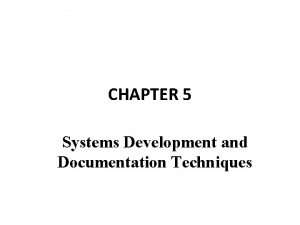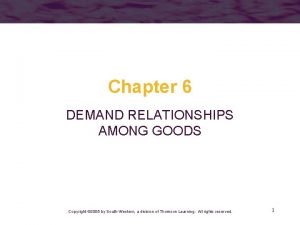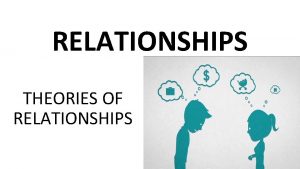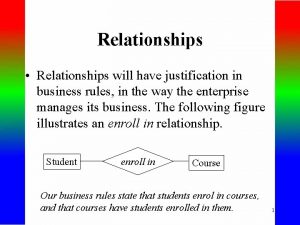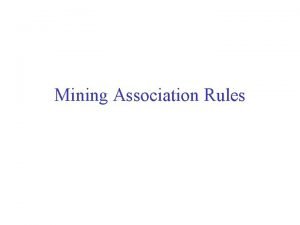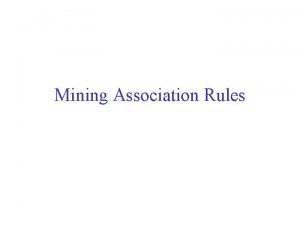Selftuning of the Relationships among Rules Components in
















- Slides: 16

Self-tuning of the Relationships among Rules’ Components in Active Database Systems David Botzer and Opher Etzion IEEE Transactions on Knowledge and Data Engineering, Mar. 2004

Active Database Systems n Detect events and trigger actions according to specified conditions. n Event-Condition-Action (ECA) Rules 1. Event detected 2. Rules identified 3. Conditions evaluated 4. Actions activated (event triggered)

Performance Issues n No flexibility for: – Partitioning rules to transactions – Specifying timing constraints n Possible solution: – Add design primitives – Use “Coupling Modes” as a design primitive

Coupling Modes n Definition: – A package of decisions about the interrelationships among ECA components. n Example: – A condition should be evaluated immediately when the event is detected, delaying any other activity in the transaction.

Solution Problems n Coupling mode research prototypes express only a subset of design alternatives. 1. 2. n Event/Condition/Action Systems designers might not employ design primitives / coupling modes correctly.

Author’s Proposed Solution n Self-tuning model for optimizing: 1. 2. 3. n n Response time of system activities (esp. time critical) Storage space of system parameters/variables Goal (cost-benefit) function for system needs Uses independent, specified “goal function” Two-phase: 1. 2. Select from original coupling modes Select from new “coupling policies”

Original Coupling Modes n n n Immediate Deferred Detached Parallel Dependent Detached Sequential Dependent Detached Independent

Coupling Mode Extension n Reason: – Provides a significant quantity of new possible combinations – Allows for interrule coupling, i. e. , rule -> event -> rule n Basic Assumption: – Any ECA component can be located in any transaction, and any transaction can include any ECA component.

Coupling Policies (1) n Five coupling modes are extended to “coupling policies” Transaction 2. Timing 3. Abort 4. Commit 5. Synchronization Let ‘X’ and ‘Y’ be various rule components (event, condition, action) 1. n

Coupling Policies (2) n The Transaction Policy – Partition ECA components into transactions – X and Y are executed in same/different transaction n The Timing Policy – Temporal relationship between ECA execution times – Given X and Y are in the same transaction, Y is executed immediately/generally after X

Coupling Policies (3) n The Abort Policy – Abort dependencies among transactions that execute related components n The Commit Policy – A transaction may commit when it finishes, or wait for the commit of related transactions

Coupling Policies (4) The Synchronization Policy n – – The synchronization between components and the conclusion of related transactions Seven possibilities n X Y n X Commit/Abort (Y Transaction) n Y Commit/Abort (X Transaction) n Commit/Abort (X Transaction) Y n Commit/Abort (X Transaction) Commit/Abort (Y Transaction) n Commit/Abort (Y Transaction) Commit/Abort (X Transaction) n No Synchronization

The Optimization Model

The Goal Function n Definition: – A function that the optimization model strives to minimize. n n n Independent of the solution’s algorithm Provided for every specific application Configured by system designer via GUI

Goal Function Establishment n Consider: – – – n Important activities for system evaluation Negligible activities Parameter stabilization Parameter Measurement: – – – Time costs Rules probabilities Etc.

Conclusion n Author’s Further Research: – Creation/evaluation of specific goal functions – Establishment of appropriate learning mechanism
 Periodic relationships among the elements
Periodic relationships among the elements Periodic relationships among the elements
Periodic relationships among the elements Vsdfds
Vsdfds Periodic relationships among the elements
Periodic relationships among the elements Demand relationships among goods
Demand relationships among goods Wsu blackboard worcester
Wsu blackboard worcester Hidden rules among classes
Hidden rules among classes Ground rules for relationships
Ground rules for relationships Hát kết hợp bộ gõ cơ thể
Hát kết hợp bộ gõ cơ thể Lp html
Lp html Bổ thể
Bổ thể Tỉ lệ cơ thể trẻ em
Tỉ lệ cơ thể trẻ em Chó sói
Chó sói Chụp tư thế worms-breton
Chụp tư thế worms-breton Chúa yêu trần thế
Chúa yêu trần thế Môn thể thao bắt đầu bằng từ chạy
Môn thể thao bắt đầu bằng từ chạy Thế nào là hệ số cao nhất
Thế nào là hệ số cao nhất


